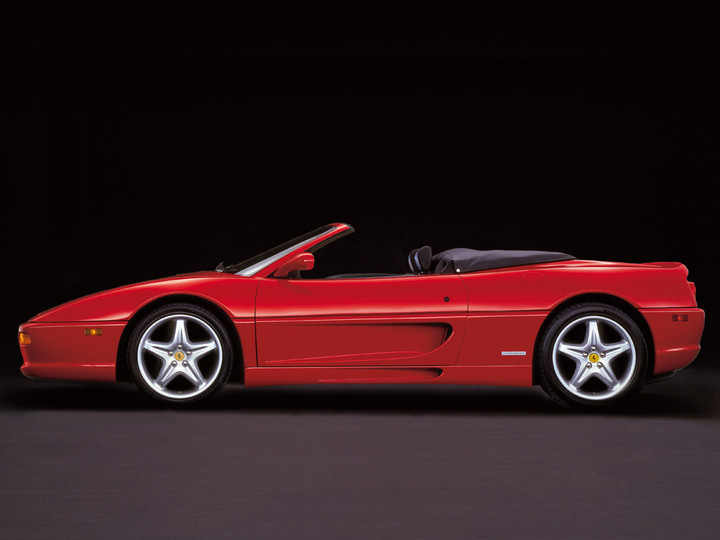

Convertible, 2 Doors, 2 Seats
24.4 l/100 km 9.64 US mpg
11.5 l/100 km 20.45 US mpg
381 Hp @ 8250 rpm.
109 Hp/l
295 km/h 183.3 mph
3496 cm3
213.34 cu. in.
8, V-engine
Rear wheel drive,
4250 mm
167.32 in.
1900 mm
74.8 in.
1450 kg
3196.7 lbs.
| Brand | Ferrari |
|---|---|
| Model | F355 (Convertible) |
| Version | F355 Spider |
| Engine version | F355 Spider (381 Hp) |
| Year production start | 1995 |
| Year production end | 1999 |
| Vehicle type | Convertible |
| Horsepower RPM | 381 Hp @ 8250 rpm. |
| Acceleration 0 - 100 kmh sec | 4.7 sec |
| Curb weight kg -lbs total |
1450 kg3196.7 lbs. |
| Overall length mm - inch |
4250 mm167.32 in. |
| Doors | 2 |
| Top Speed | 295 km/h 183.3 mph |
| Designation model | F129B |
|---|---|
| Engine position and orientation | Middle, Transverse |
| Cylinders | 8 |
| Position of cylinders | V-engine |
| Displacement (liters) |
3496 cm3213.34 cu. in. |
| Eng. horsepower RPM | 381 Hp @ 8250 rpm. |
| Horsepower per litre | 109 Hp/l |
| Weight / horsepower kg/hp - hp/tons |
3.8 kg/Hp262.8 Hp/tonne |
| Weight / torque kg/Nm - Nm/tons | 4 kg/Nm, 250.3 Nm/tonne
4 kg/Nm250.3 Nm/tonne |
| Torque Nm RPM lb-ft RPM |
363 Nm @ 6000 rpm.267.74 lb.-ft. @ 6000 rpm. |
| Bore (mm in) |
85 mm3.35 in. |
| Stroke (mm in) |
77 mm3.03 in. |
| Compression ratio | 11 |
| Fuel delivery system | Multi-point indirect injection |
| Fuel type | Petrol (Gasoline) |
| Valvetrain | 5 |
| Engine aspiration | Naturally aspirated engine |
| Engine oil liters | quarts |
9.5 l10.04 US qt | 8.36 UK qt |
| Engine coolant |
11 l11.62 US qt | 9.68 UK qt |
| Powertrain architecture | Internal Combustion engine |
| Engine location | Middle, Transverse |
| Drive configuration | Rear wheel drive |
|---|---|
| Transmission | 6 |
| Front brakes | Ventilated discs |
|---|---|
| Rear brakes | Drum |
| Anti-lock brake system | ABS (Anti-lock braking system) |
| Front suspension | Coil spring |
|---|---|
| Rear suspension | Helical spring |
| Wheels size | 225/40 R18; 265/40 R18 |
|---|
| Passengers seats | 2 |
|---|---|
| Trunk space min liter | cu. Ft. |
220 l7.77 cu. ft. |
| Overall length mm - inch |
4250 mm167.32 in. |
|---|---|
| Overall width mm -inch |
1900 mm74.8 in. |
| Overall height mm -inch |
1170 mm46.06 in. |
| Wheelbase mm - inch |
2450 mm96.46 in. |
| Track width front mm - inch |
1514 mm59.61 in. |
| Track width rear mm - inch |
1615 mm63.58 in. |
| Curb weight kg -lbs total |
1450 kg3196.7 lbs. |
|---|---|
| Gross weight kg -lbs total |
1700 kg3747.86 lbs. |
| Capacities kg - lbs |
250 kg551.16 lbs. |
| Fuel tank liters | gallons |
82 l21.66 US gal | 18.04 UK gal |
| City l/100km - mpg |
24.4 l/100 km9.64 US mpg |
|---|---|
| Highway l/100 km - mpg |
11.5 l/100 km20.45 US mpg |
8 CYLINDER V-Engine
https://www.thecarspec.net/components/engine/8-cylinders-v